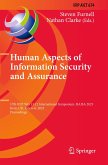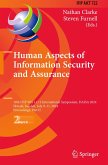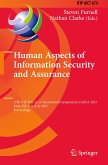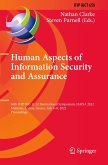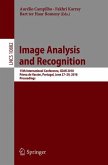Human Aspects of Information Security and Assurance
19th IFIP WG 11.12 International Symposium, HAISA 2025, Mytilene, Greece, July 7-9, 2025, Proceedings
Herausgegeben:Furnell, Steven; Clarke, Nathan
Human Aspects of Information Security and Assurance
19th IFIP WG 11.12 International Symposium, HAISA 2025, Mytilene, Greece, July 7-9, 2025, Proceedings
Herausgegeben:Furnell, Steven; Clarke, Nathan
- Gebundenes Buch
- Merkliste
- Auf die Merkliste
- Bewerten Bewerten
- Teilen
- Produkt teilen
- Produkterinnerung
- Produkterinnerung
This volume constitutes the proceedings of the 19th IFIP WG 11.12 International Symposium on Human Aspects of Information Security and Assurance, HAISA 2025, held in Mytilene, Greece, during July 7 9, 2025.
The 30 full papers presented were carefully reviewed and selected from 38 submissions. The papers are organized in the following topical sections: Awareness & Education; Security Culture; Privacy and Technical Attacks & Defenses.
Andere Kunden interessierten sich auch für
![Human Aspects of Information Security and Assurance Human Aspects of Information Security and Assurance]() Human Aspects of Information Security and Assurance91,99 €
Human Aspects of Information Security and Assurance91,99 €![Human Aspects of Information Security and Assurance Human Aspects of Information Security and Assurance]() Human Aspects of Information Security and Assurance68,99 €
Human Aspects of Information Security and Assurance68,99 €![Human Aspects of Information Security and Assurance Human Aspects of Information Security and Assurance]() Human Aspects of Information Security and Assurance61,99 €
Human Aspects of Information Security and Assurance61,99 €![Human Aspects of Information Security and Assurance Human Aspects of Information Security and Assurance]() Human Aspects of Information Security and Assurance91,99 €
Human Aspects of Information Security and Assurance91,99 €![Human Aspects of Information Security and Assurance Human Aspects of Information Security and Assurance]() Human Aspects of Information Security and Assurance91,99 €
Human Aspects of Information Security and Assurance91,99 €![Human Aspects of Information Security and Assurance Human Aspects of Information Security and Assurance]() Human Aspects of Information Security and Assurance91,99 €
Human Aspects of Information Security and Assurance91,99 €![Image Analysis and Recognition Image Analysis and Recognition]() Image Analysis and Recognition88,99 €
Image Analysis and Recognition88,99 €-
-
-
This volume constitutes the proceedings of the 19th IFIP WG 11.12 International Symposium on Human Aspects of Information Security and Assurance, HAISA 2025, held in Mytilene, Greece, during July 7 9, 2025.
The 30 full papers presented were carefully reviewed and selected from 38 submissions. The papers are organized in the following topical sections: Awareness & Education; Security Culture; Privacy and Technical Attacks & Defenses.
The 30 full papers presented were carefully reviewed and selected from 38 submissions. The papers are organized in the following topical sections: Awareness & Education; Security Culture; Privacy and Technical Attacks & Defenses.
Produktdetails
- Produktdetails
- IFIP Advances in Information and Communication Technology 761
- Verlag: Springer / Springer Nature Switzerland / Springer, Berlin
- Artikelnr. des Verlages: 89575612, 978-3-032-02503-6
- Seitenzahl: 464
- Erscheinungstermin: 30. Oktober 2025
- Englisch
- Abmessung: 241mm x 160mm x 31mm
- Gewicht: 855g
- ISBN-13: 9783032025036
- ISBN-10: 3032025036
- Artikelnr.: 74899152
- Herstellerkennzeichnung
- Springer-Verlag GmbH
- Tiergartenstr. 17
- 69121 Heidelberg
- ProductSafety@springernature.com
- IFIP Advances in Information and Communication Technology 761
- Verlag: Springer / Springer Nature Switzerland / Springer, Berlin
- Artikelnr. des Verlages: 89575612, 978-3-032-02503-6
- Seitenzahl: 464
- Erscheinungstermin: 30. Oktober 2025
- Englisch
- Abmessung: 241mm x 160mm x 31mm
- Gewicht: 855g
- ISBN-13: 9783032025036
- ISBN-10: 3032025036
- Artikelnr.: 74899152
- Herstellerkennzeichnung
- Springer-Verlag GmbH
- Tiergartenstr. 17
- 69121 Heidelberg
- ProductSafety@springernature.com
.- Awareness & Education.
.- Thematic Analysis of Cybersecurity Awareness Strategies and Approaches.
.- Investigating Cyber-Situational Awareness for Cyber Ranges in Offshore Operations.
.- I m in Portrayal of Hacking in Movies and TV Shows.
.- Cybersecurity and emerging technologies: Investigating individuals ability to identify deepfake media.
.- Learning to Deceive: Attacker Skill Acquisition in a Vishing Simulation Study.
.- Transmission, Evaluation, Culture Internal Communications as a Catalyst for Information Security Awareness.
.- Theoretical Underpinnings for Consideration in the Design of a Secure Programming Course.
.- Cybersecurity Vulnerabilities of Female Learners: The Case of South African Marginalised School.
.- Supporting cyber security knowledge and skills in non-computing disciplines.
.- Multidisciplinary Pathways into Cyber Threat Intelligence Roles: Mapping Knowledge Areas and Transferable Skills.
.- Security Culture.
.- How Digital Evidence Seizure Times Affect Swedish Citizens Willingness to Report Crimes.
.- A Cyber4Dev Security Culture Model for SMMEs in South Africa.
.- Reimagining AI as a Psychosocial Buffer: A Conceptual Model for Mitigating Burnout and Quiet Quitting in Cybersecurity.
.- Factors Contributing to Cybersecurity Fatigue.
.- Increasing a Product s Perceived Cybersecurity by Indicating the Country of Origin.
.- Privacy.
.- Digital Coercive Control: Towards Understanding Item Finder Misuse.
.- Of course, that s not feasible for everyone Compiling and Evaluating Privacy Recommendations in Expert Interviews.
.- A Holistic Profile for the Information Privacy Aware and Competent User.
.- Reducing Role Ambiguity for Organisational Data Privacy Compliance.
.- Security and Privacy Implications of AI-Driven Digital Phenotyping.
.- Adopting LLMs in Internet of Cloud Ecosystems: Identifying the Key Privacy Challenges.
.- Public Perceptions of Trustworthy AI: Insights from a Longitudinal Study of UK News Media.
.- Technical Attacks & Defenses.
.- Beyond phishing: A human-centered exploration of cyber incident reporting.
.- Words matter: Applying the Elaboration Likelihood Model to Examine the persuasive cues evident in True and Fake News about the Indigenous Voice to Parliament .
.- A Structured Approach to Log Design: Addressing Security and Compliance Gaps in Software Development.
.- A Literature Review on Rule-Based Systems as Decision Support Systems.
.- Online Authentication for Users with Visual Disabilities.
.- SoK: A Systematic Review of Context- and Behavior-Aware Adaptive Authentication in Mobile Environments.
.- On the Inconsistency of Update-Related Vulnerabilities.
.- Cybersecurity Strategies to Mitigate Insider Threats in Multi-Cloud Environments.
.- Thematic Analysis of Cybersecurity Awareness Strategies and Approaches.
.- Investigating Cyber-Situational Awareness for Cyber Ranges in Offshore Operations.
.- I m in Portrayal of Hacking in Movies and TV Shows.
.- Cybersecurity and emerging technologies: Investigating individuals ability to identify deepfake media.
.- Learning to Deceive: Attacker Skill Acquisition in a Vishing Simulation Study.
.- Transmission, Evaluation, Culture Internal Communications as a Catalyst for Information Security Awareness.
.- Theoretical Underpinnings for Consideration in the Design of a Secure Programming Course.
.- Cybersecurity Vulnerabilities of Female Learners: The Case of South African Marginalised School.
.- Supporting cyber security knowledge and skills in non-computing disciplines.
.- Multidisciplinary Pathways into Cyber Threat Intelligence Roles: Mapping Knowledge Areas and Transferable Skills.
.- Security Culture.
.- How Digital Evidence Seizure Times Affect Swedish Citizens Willingness to Report Crimes.
.- A Cyber4Dev Security Culture Model for SMMEs in South Africa.
.- Reimagining AI as a Psychosocial Buffer: A Conceptual Model for Mitigating Burnout and Quiet Quitting in Cybersecurity.
.- Factors Contributing to Cybersecurity Fatigue.
.- Increasing a Product s Perceived Cybersecurity by Indicating the Country of Origin.
.- Privacy.
.- Digital Coercive Control: Towards Understanding Item Finder Misuse.
.- Of course, that s not feasible for everyone Compiling and Evaluating Privacy Recommendations in Expert Interviews.
.- A Holistic Profile for the Information Privacy Aware and Competent User.
.- Reducing Role Ambiguity for Organisational Data Privacy Compliance.
.- Security and Privacy Implications of AI-Driven Digital Phenotyping.
.- Adopting LLMs in Internet of Cloud Ecosystems: Identifying the Key Privacy Challenges.
.- Public Perceptions of Trustworthy AI: Insights from a Longitudinal Study of UK News Media.
.- Technical Attacks & Defenses.
.- Beyond phishing: A human-centered exploration of cyber incident reporting.
.- Words matter: Applying the Elaboration Likelihood Model to Examine the persuasive cues evident in True and Fake News about the Indigenous Voice to Parliament .
.- A Structured Approach to Log Design: Addressing Security and Compliance Gaps in Software Development.
.- A Literature Review on Rule-Based Systems as Decision Support Systems.
.- Online Authentication for Users with Visual Disabilities.
.- SoK: A Systematic Review of Context- and Behavior-Aware Adaptive Authentication in Mobile Environments.
.- On the Inconsistency of Update-Related Vulnerabilities.
.- Cybersecurity Strategies to Mitigate Insider Threats in Multi-Cloud Environments.
.- Awareness & Education.
.- Thematic Analysis of Cybersecurity Awareness Strategies and Approaches.
.- Investigating Cyber-Situational Awareness for Cyber Ranges in Offshore Operations.
.- I m in Portrayal of Hacking in Movies and TV Shows.
.- Cybersecurity and emerging technologies: Investigating individuals ability to identify deepfake media.
.- Learning to Deceive: Attacker Skill Acquisition in a Vishing Simulation Study.
.- Transmission, Evaluation, Culture Internal Communications as a Catalyst for Information Security Awareness.
.- Theoretical Underpinnings for Consideration in the Design of a Secure Programming Course.
.- Cybersecurity Vulnerabilities of Female Learners: The Case of South African Marginalised School.
.- Supporting cyber security knowledge and skills in non-computing disciplines.
.- Multidisciplinary Pathways into Cyber Threat Intelligence Roles: Mapping Knowledge Areas and Transferable Skills.
.- Security Culture.
.- How Digital Evidence Seizure Times Affect Swedish Citizens Willingness to Report Crimes.
.- A Cyber4Dev Security Culture Model for SMMEs in South Africa.
.- Reimagining AI as a Psychosocial Buffer: A Conceptual Model for Mitigating Burnout and Quiet Quitting in Cybersecurity.
.- Factors Contributing to Cybersecurity Fatigue.
.- Increasing a Product s Perceived Cybersecurity by Indicating the Country of Origin.
.- Privacy.
.- Digital Coercive Control: Towards Understanding Item Finder Misuse.
.- Of course, that s not feasible for everyone Compiling and Evaluating Privacy Recommendations in Expert Interviews.
.- A Holistic Profile for the Information Privacy Aware and Competent User.
.- Reducing Role Ambiguity for Organisational Data Privacy Compliance.
.- Security and Privacy Implications of AI-Driven Digital Phenotyping.
.- Adopting LLMs in Internet of Cloud Ecosystems: Identifying the Key Privacy Challenges.
.- Public Perceptions of Trustworthy AI: Insights from a Longitudinal Study of UK News Media.
.- Technical Attacks & Defenses.
.- Beyond phishing: A human-centered exploration of cyber incident reporting.
.- Words matter: Applying the Elaboration Likelihood Model to Examine the persuasive cues evident in True and Fake News about the Indigenous Voice to Parliament .
.- A Structured Approach to Log Design: Addressing Security and Compliance Gaps in Software Development.
.- A Literature Review on Rule-Based Systems as Decision Support Systems.
.- Online Authentication for Users with Visual Disabilities.
.- SoK: A Systematic Review of Context- and Behavior-Aware Adaptive Authentication in Mobile Environments.
.- On the Inconsistency of Update-Related Vulnerabilities.
.- Cybersecurity Strategies to Mitigate Insider Threats in Multi-Cloud Environments.
.- Thematic Analysis of Cybersecurity Awareness Strategies and Approaches.
.- Investigating Cyber-Situational Awareness for Cyber Ranges in Offshore Operations.
.- I m in Portrayal of Hacking in Movies and TV Shows.
.- Cybersecurity and emerging technologies: Investigating individuals ability to identify deepfake media.
.- Learning to Deceive: Attacker Skill Acquisition in a Vishing Simulation Study.
.- Transmission, Evaluation, Culture Internal Communications as a Catalyst for Information Security Awareness.
.- Theoretical Underpinnings for Consideration in the Design of a Secure Programming Course.
.- Cybersecurity Vulnerabilities of Female Learners: The Case of South African Marginalised School.
.- Supporting cyber security knowledge and skills in non-computing disciplines.
.- Multidisciplinary Pathways into Cyber Threat Intelligence Roles: Mapping Knowledge Areas and Transferable Skills.
.- Security Culture.
.- How Digital Evidence Seizure Times Affect Swedish Citizens Willingness to Report Crimes.
.- A Cyber4Dev Security Culture Model for SMMEs in South Africa.
.- Reimagining AI as a Psychosocial Buffer: A Conceptual Model for Mitigating Burnout and Quiet Quitting in Cybersecurity.
.- Factors Contributing to Cybersecurity Fatigue.
.- Increasing a Product s Perceived Cybersecurity by Indicating the Country of Origin.
.- Privacy.
.- Digital Coercive Control: Towards Understanding Item Finder Misuse.
.- Of course, that s not feasible for everyone Compiling and Evaluating Privacy Recommendations in Expert Interviews.
.- A Holistic Profile for the Information Privacy Aware and Competent User.
.- Reducing Role Ambiguity for Organisational Data Privacy Compliance.
.- Security and Privacy Implications of AI-Driven Digital Phenotyping.
.- Adopting LLMs in Internet of Cloud Ecosystems: Identifying the Key Privacy Challenges.
.- Public Perceptions of Trustworthy AI: Insights from a Longitudinal Study of UK News Media.
.- Technical Attacks & Defenses.
.- Beyond phishing: A human-centered exploration of cyber incident reporting.
.- Words matter: Applying the Elaboration Likelihood Model to Examine the persuasive cues evident in True and Fake News about the Indigenous Voice to Parliament .
.- A Structured Approach to Log Design: Addressing Security and Compliance Gaps in Software Development.
.- A Literature Review on Rule-Based Systems as Decision Support Systems.
.- Online Authentication for Users with Visual Disabilities.
.- SoK: A Systematic Review of Context- and Behavior-Aware Adaptive Authentication in Mobile Environments.
.- On the Inconsistency of Update-Related Vulnerabilities.
.- Cybersecurity Strategies to Mitigate Insider Threats in Multi-Cloud Environments.


